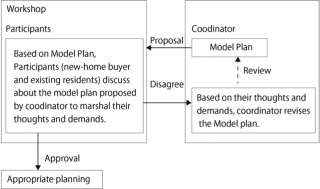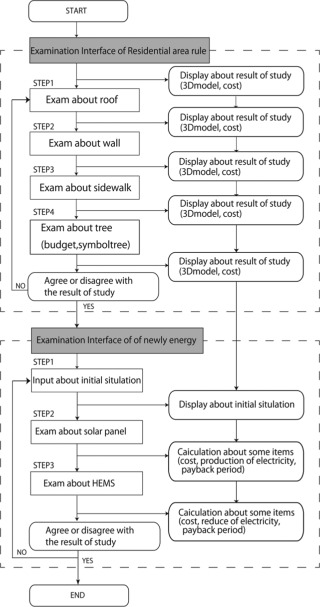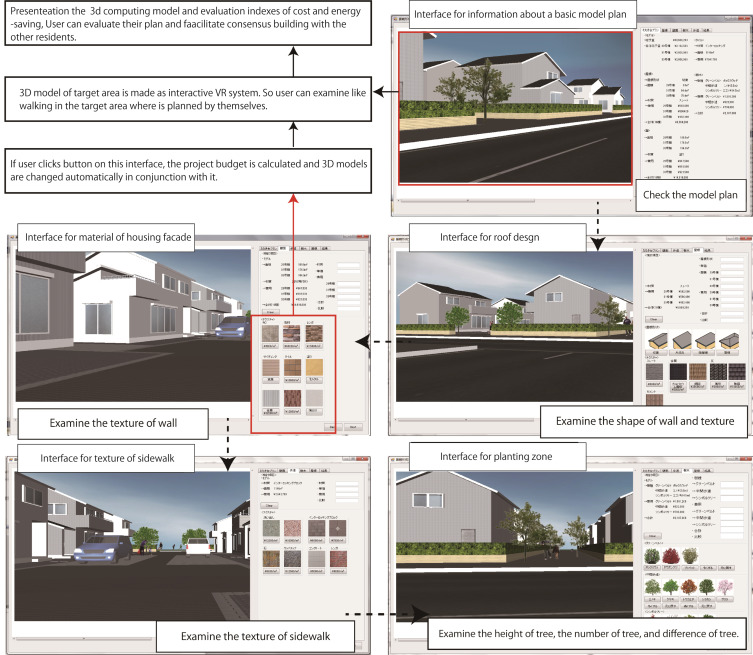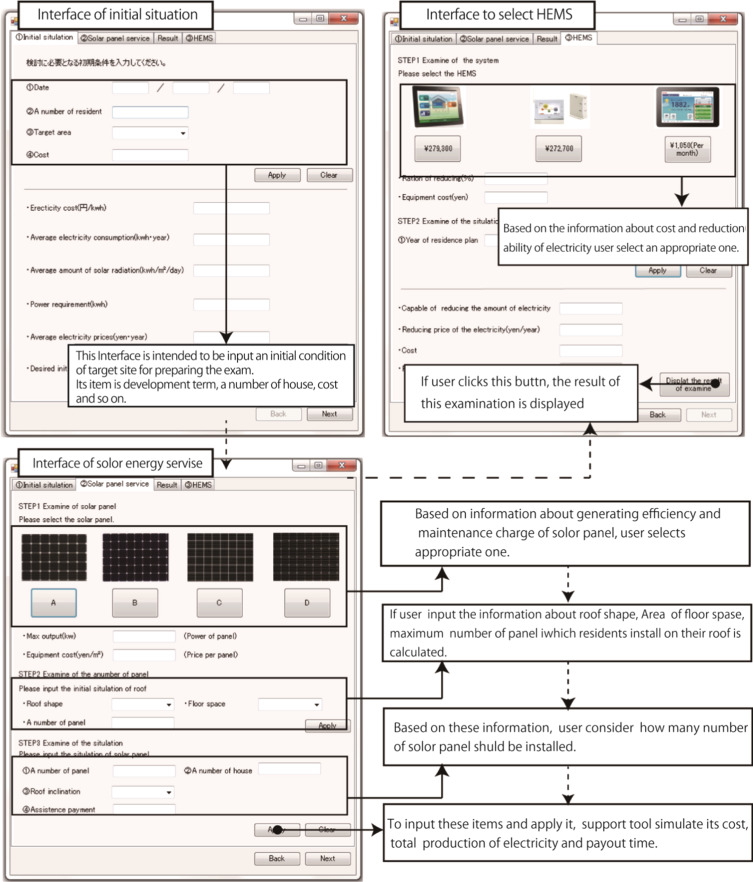Abstract
A reduction of environmental burdens is currently required. In particular, proposing a new approach for the construction of a smart city using renewable energy is important. The technological development of a smart city is founded building equipment and infrastructure. However, planning methods and their techniques using the collaboration approach with residents are only just developing. This study aimed to develop a support tool for the construction of a smart city using renewable energy while facilitating consensus-building efforts among residents using the method for a cooperative housing development. We organized the supporting methods for the construction of residential area using the cooperative method. Then, we developed supporting tools that interface the computer with these methods. We examined the support techniques for the construction of a residential area using renewable energy technology by analyzing Japanese cases of a smart city. Moreover, we developed a support tool for the construction of a smart city on a trial basis. We integrated the smart city construction tools and the cooperative housing construction support tool. This tool has a 3D modeling system that helps residents to easily understand the space image as a result of the examination. We also developed a professional supporting tool that residents can consider for cost-effectiveness in renewable energy and its environmental load reduction rate for the planning of a smart city.
Keywords
Cooperative method ; Consensus building ; Smart city ; Renewable energy ; Visual image ; Project evaluation
1. Introduction
Cooperative housing methods that combine consensus-building among residents and their own efforts to create a good environment and an attractive local community are currently required. In these methods, the workshop creates a hopeful living image. However, it required long periods of time and professional support and is not fully exploited.
A reduction of environmental burdens is required from the viewpoint of the global environment and energy saving. A smart city, which is a thorough environment-conscious city planning that contributes to enhancing energy efficiency, is considered an appropriate way to have a sustainable society. It provides not only the environment and technology but also living conveniences and comfort. Therefore, proposing a new approach to construct a smart city is important.
As for the technological development of a smart city, the field of building equipment and infrastructure is active. However, planning methods and techniques for the collaboration with residents have just emerged. Support for consensus building in the stage of the planning can help in a situation in which a planner proposes these methods and technology.
Earlier research on supporting the consensus building in planning shows the following important points: the method of space image sharing of the plan and the project evaluation methods in planning (Takiguchi et al ., 2003 ; Koga et al ., 2008 ; Arima et al ., 2007 ; Nagai et al ., 2011 ; Koga et al ., 2011 ).
Takiguchi et al. (2003) studied consensus building in the workshop of a park. Koga et al. (2008) examined it in town landscape planning. Arima et al. (2007) investigated it in the workshop of town panning. A number of studies have been conducted on project evaluation in planning. Nagai et al. (2011) studied project evaluation in urban development for low carbon, and Koga et al. (2011) examined it in urban redevelopment. However, these studies did not conduct a project evaluation to calculate both CO2 reduction and the business budget.
This study aimed to develop a support tool for the residential construction of a smart city with renewable energy technology while facilitating consensus building using the cooperative method.
By examining a 3D modeling of a space image of a residence, CO2 reduction, and the business budget, a planning of residence that reflects the intention of the residents is supported. Therefore, this study is different from previous research.
2. Research method
We developed a supporting method for residential area construction using the cooperative method. On the basis of this information, we developed supporting tools interfaced with a computer using the methods. We examined the support technique for residential construction with renewable energy by analyzing the case of a construction of a smart city in Japan. We developed a support tool for the construction of a smart city on a trial basis. Moreover, we integrated smart city construction tools and the cooperative housing construction support tool. We developed a 3D modeling technique for the support tool through which users can easily understand the space image from the result of the examination. We also developed a professional supporting tool for a smart city planning that residents can use for examining the cost-effectiveness of renewable energy and the details of the environmental load reduction rate.
3. Supporting contents for planning and consensus building
In this section, we analyze the improvements in planning and consensus building using the cooperative method and the idea of a smart city. Moreover, we examine supporting contents for developing a support tool.
3.1. Planning of housing development using the cooperative method
We analyze the planning methods for cooperative housing in this section. In the construction of cooperative housing, a workshop is often held in a living environment that reflects the opinions of inhabitants. In this workshop, the development of rules for construction and habitat design is considered important. Residential area rules mainly consist of two agreements, namely, the environmental agreement on the use of the entire residential area and the building agreement on the design of a house. In this section, we also explain the case of the cooperative village of Kasugabaru Minami, which represents both the environmental and building agreements (Nakanishi et al., 2011 ). Table 1 shows the environmental agreement and Table 2 shows the building agreement for this village. Interestingly, an environmental rule is set in each area. Coordinators set tree rules on plant location, symbol tree species, and so on for each house.
| Unified regulations for a whole designated area | The target area must be designated to construct a residential zone through an architectural plan for the housing construction. |
|---|---|
| A tree with over 3 m in height must be planted in each housing lot. | |
| The target area where houses have a louvered balcony must be specified. | |
| Rules for private space | All residents have the responsibility to maintain it by themselves. |
| Rules for public space | All union members should offer a facility for maintenance. |
| Rules for landscape | Installation of equipment attached to buildings that impair scenery is not allowed. |
| Scale | Maximum height within 9 m |
|---|---|
| Building use | Private house only |
| Form and material of façade | Maintain harmony with the surroundings |
| Opening specification | Limited windows and doors to maintain residents׳ privacy |
| Entrance | The common space should face the alcove |
| Marquee | No attachment |
| Roof | Single-shed roof facing the parking |
Fig. 1 presents a discussion method for the cooperative village of Kasugabaru Minami. For topics such as the selection of symbolic tree species in a residential area, participants can discuss actively and easily their opinions and demands with each other. For the topics that require some expertize, such as exterior and design of a building, coordinators prepare a proposal in advance. They explain and gain the approval of residents at the plenary assembly.
|
|
|
Fig. 1. Discussion method in the workshop. |
In the workshop, the cooperative method mainly sets the residential area rules, confirms the contractual relationship, and examines the design proposal. To set a rule, facilitating consensus building among participants is necessary. To build a consensus smoothly, sharing information on the space image and the evaluation of construction costs is important.
3.2. Planning a smart city
3.2.1. Questionnaire survey for smart city planning
To understand the awareness about and requirements for a smart city, we conducted a questionnaire survey on smart city planning among local citizens of Simonoseki City in the Yamaguchi Prefecture.1 The investigation period was from January 23 to 31, XXXX.
The awareness about a smart city, the interest in solar power service, the interest in electrical control service, the initial investable value of an energy conservation technology after its introduction are presented in Table 3 , Table 4 , Table 5 ; Table 6 .
| Awareness about smart city | Number | Ratio |
|---|---|---|
| Fully understand | 7 | 3.9 |
| Only by name | 42 | 23.5 |
| Not understand | 130 | 72.6 |
| NA | 3 | 1.6 |
| Number | Ratio | |
| Very interested | 42 | 23.2 |
|---|---|---|
| Interested | 53 | 29.3 |
| Neither | 30 | 16.6 |
| Slightly interested | 37 | 20.4 |
| Not interested | 19 | 10.5 |
| NA | 1 | 0.5 |
| Total | 182 | 100 |
| Number | Ratio | |
|---|---|---|
| Very Interested | 38 | 21.1 |
| Interested | 60 | 33.3 |
| Neither | 35 | 19.4 |
| Slightly interested | 28 | 15.6 |
| Not interested | 19 | 10.6 |
| NA | 2 | 1.1 |
| Total | 182 | 100 |
| Initial cost of equipment (yen) | Number | Ratio |
|---|---|---|
| 0 | 19 | 20.9 |
| 0–500 | 7 | 7.7 |
| 500–1000 | 11 | 12.1 |
| 1000–2000 | 20 | 22.0 |
| 2000–5000 | 15 | 16.5 |
| 5000–10,000 | 8 | 8.8 |
| 10,000–50,000 | 6 | 6.6 |
| >50,000 | 5 | 5.5 |
| NA | 91 | 50.0 |
| Total | 182 | 100 |
3.2.2. Awareness of citizen
Table 4 shows that residents are interest in the smart city, but most of them have poor knowledge of it. Therefore, a significant hurdle to innovating exists. In addition, residents are unwillingness to pay a certain fee other than the necessary maintenance charge. To introduce the use of renewable energy, users need to have professional knowledge about HEMS and solar panel service. Furthermore, users need to understand the exact effects and benefits when they use renewable energy.
3.3. Study on the supporting contents
In this section, we examine the supporting contents on planning based on the analysis of the improvement on planning and consensus building using the cooperative method, smart city, and previous research.
3.3.1. Project evaluation for consensus building in planning
When planning a residential area using the cooperative method, making a common rule in consensus building is important. Therefore, an appropriate project evaluation is required for consensus building among residents. For example, residents need to know that the initial investment on renewable energy is worthwhile and that it could reduce electricity consumption when solar panel service and HEMS are introduced.2 Therefore, as supporting contents, the initial investment, electricity bill, and payback period should be calculated and presented.
3.3.2. 3D modeling for sharing the space image
In planning residential areas, residents׳ opinions should be reflected on the plan, such as in developing the landscape and housing design. Therefore, preparing the items is important to examine the plan and to reflect the opinions of residents. Therefore, we present the supporting contents using the 3D model to easily understand the image, such as a tree and texture.
4. Outline of the support tool
In this section, we describe our development environment and the composition of the support tool. Table 7 shows the development environment for the support tool. We used Microsoft Visual Basic 2010 Express to develop the interface and Google SketchUp Pro and Adobe Director for the 3D modeling. A support tool is composed of two interfaces, namely, one for the residential area rule and one for renewable energy. The interface for the residential area rule is composed of four main items: a roof, a wall, sidewalk, and trees in a residential area. An interface for renewable energy consists of three main items: initial condition, solar power service, and HEMS.
| Hardware | Software |
|---|---|
| DELL XPS 4100 | Visual Basic 2010 Express |
| CPU: intel® core™ i7 | (Used for development of Interface) |
| Memory: 12.00 GB | Sketch Up Pro8 |
| Adobe director 11.5 | |
| (Used for 3D modeling) |
Fig. 2 shows the flowchart of the support tool. Users employ the following flow at an interface for a residential area rule. First, users check the model plan of the residential area rule at the interface of the initial condition. The contents for the 3D model and project budget are examined. Second, each study item is examined. Third, the project evaluation items are verified by the interface of the study result.
|
|
|
Fig. 2. Sequence chart of the support tool usage. |
Users work with the following flow at an interface for renewable energy. In the initial condition of the interface, the target area, the initial investigation, and the number of buildings are inputted. A solar power service and HEMS are then examined. The examination result is verified at the interface. According to this flow, users are able to make the actual plan with consensus building.
5. Development of the support tool
We describe the support tool in this section. Detailed information and the ways of using each interface are also presented.
5.1. Interface of the residential area rule
The support tool is used to create a residential area rule in the workshop using the cooperative method. Fig. 3 shows the outline of the support tool. The tool assists in the examination of the texture of the tree, roof, and wall, as it easily creates spatial image. The opinions of prospective tenants can be reflected in the residential area rule. Through the selection of textures, the support tool calculates the cost in conjunction with the 3D model automatically.
|
|
|
Fig. 3. Outline of the interface for residential area planning. |
Based on these items, participants make a residential area rule in the workshop. The CG model is created using Flash Movie. The model can walk through and move freely in a virtual space with perspective.
5.1.1. Interface for the model plan
Referring to the examination, users check the model plan at this interface. The interface not only shows a 3D model in virtual reality (VR) but also checks other information required in the examination. Moreover, users can confirm not only the planning area but also their own site and house. The model can be played in VR on the left side of this interface. Therefore, the Flash Player is required to play the Flash movie. By selecting a tab at the interface, checking the model plan at any time is possible.
5.1.2. Interface for the roof
This interface intends to examine the roof of the house and to achieve unity of the townscape in a residential area. The examination contents are the roof shape and texture. The roof shape has four patterns: gable, flat roof, hipped, and shed. By selecting a plan, a roof shape can be changed in VR. To match the roof shape, four different patterns of residential areas are prepared. By selecting a button indicating a roof shape, the 3D model can be changed at this interface, and users can confirm the space image.
Moreover, the cost and the roof shape and area are shown to match the selection of a plan. The support tool is able to examine texture. By selecting texture consisting of four patterns, namely, cement, slate system, metal based, and tile, the interface can examine the material and the color.
5.1.3. Interface for the wall
This interface intends to examine the wall of the house. The examination contents are the material and the color of the wall. By selecting texture that consists of 11 patterns, the interface can examine the material and the color of the wall. Texture consists of six patterns, namely, RC, stone, brick, siding, tile, and paint.
By selecting texture, the texture of the wall can be changed. Therefore, users can change the image of the wall.
The support tool can also show the changes in the business expense portion of the wall.
5.1.4. Interface for the sidewalk
This interface intends to examine the sidewalk of a residential area. The examination contents are the material and the color of the sidewalk. Texture consists of six patterns. By selecting texture, the texture of the sidewalk can be changed.
Users can change the image and show the budget adjustments of the sidewalk. Therefore, users can facilitate consensus building against the project budget and space image.
5.1.5. Interface for the tree
This interface intends to examine the trees in a residential area. The examination contents are hedge covering around the housing, symbol tree in each house, and street tree in the middle of the sidewalk. To examine the hedge, users can select three types: boxwood, dougantutuji, and prepet. The number of hedges can also be changed. To examine the symbol tree in each house, users can select four types: itayakaede, kobushi, akinire, and egonoki. The height and the number of trees can also be changed. In examining street trees in the middle of the corridor at this interface, users can select 11 tree species, such as nettle, Zelkowa, trident maple, Quercus myrsinifolia , and cherry. Changing the height and number is also possible.
5.2. Interface of renewable energy
5.2.1. Details of the support tool
This support tool is used to examine the introduction of solar energy service and HEMS. These items are important when planning a smart city. Fig. 4 shows the outline of the interface. The examination method is presented afterwards.
|
|
|
Fig. 4. Outline of the interface for new energy. |
First, users input the required items, such as cost, number of residents, and initial condition. Second, the costs and benefits are calculated automatically at the interface. Finally, on the basis of these data, users confirm and consider the common rule on renewable energy. Clearly, this support tool is different from the previous ones. First, it can select several solar panels. Second, it can simulate innovation using these technologies in a residential area.
5.2.2. Details of the interface
(1) Interface for the initial condition
This interface inputs the initial condition to prepare for the examination. The input items are date, number of houses, target area, and cost. Necessary data are calculated to input these items and apply them.
(2) Interface for the solar energy service
This interface intends to examine and simulate the innovation the solar energy service. The examination has three steps.
First, users can select the appropriate solar panel using information on power generation efficiency and investment cost. Second, users examine the number of solar panels that can be installed on the roof using roof shape and floor space. Third, users examine the installation requirements using the number of solar panels, assistance payment, and gradients.
To input these items and apply them, the support tool simulates the cost, total production of electricity, and payout time. The examination results are then displayed.
(3) Interface for the HEMS
This interface intends to examine and simulate the innovation of HEMS. This examination has two steps. First, users can select the HEMS using information on cost and reduction ability of electricity. Second, users examine the installation of the requirements. Information such as year of residence plan and assistance payment is inputted. By inputting these items and apply them, the support tool simulates the cost, total production of electricity, and payout time in the innovation of HEMS. The examination results are also displayed.
6. Conclusion
In this study, we developed a support tool that could examine both space images after construction and project evaluation using the cooperative method. The target persons of the support tool are the prospective tenants who can live in a residential area through the cooperative method. The support tool is used in the workshop for planning.
The results of the study are as follows:
- The support tool is considered a useful tool to examine the project evaluation for consensus building among participants during discussion and planning in a workshop. For example, it can examine the innovation of a renewable energy, such as a solar panel service and HEMS.
- Through the use of a 3D model, the support tool can provide the space image after construction and examine the design plan in a residential area, such as the façade of a house and plants in a residential area.
- By integrating these contents, the support tool can confirm the space image after construction and project evaluation at the same time.
The interface can be improved as follows:
- In examining renewable energy, the interface should add other support contents such as wind power service and bio-mas service in the support tool.
- The support tool should be revised to obtain a wider range of examination, such as housing and site plotting and road construction.
References
- Arima et al., 2007 T. Arima, T. Yurino, K. Hidaka; Utilization and evaluation of virtual reality in urban design workshops; J. Archit. Plan. Archit. Inst. Japan, 617 (2007), pp. 79–85
- Koga et al., 2008 M. Koga, S. Ikaruga, K. Tadamura, A. Ohgai, M. Matsuo; Study on image sharing support method in landscape planning using information technology; J. Archit. Plan. Archit. Inst. Japan, 633 (2008), pp. 2409–2416
- Koga et al., 2011 M. Koga, S. Ikaruga, A. Ohgai, K. Tadamura, T. Kobayashi; A study on a consensus building support method for planning in urban redevelopment projects; J. Archit. Plan. Archit. Inst. Japan, 660 (2011), pp. 405–414
- Nagai et al., 2011 Y. Nagai, A. Ohgai, S. Ikaruga, M. Koga, K. Takeshi, A. Inoue, J. Sugiyama; Development of a city planning support tool for low-carbon city; In: Proceedings of AIJ Tyugoku Chapter Architectural Research Meeting, 49 (2011), pp. 661–664
- Nakanishi et al., 2011 Y. Nakanishi, S. Ikaruga, T. Kobayashi; A study on development plan for residential area using cooperative method; In: Proceedings of AIJ Tyugoku Chapter Architectural Research Meeting, 33 (2011), pp. 727-1–727-4
- Takiguchi et al., 2003 H. Takiguchi, T. Arima, T. Sakai, S. Hagishima; Multimedia computer system supporting park-planning workshop; J. Archit. Plan. Archit. Inst. Japan, 547 (2003), pp. 129–135
Notes
1. Smart community town Shimonoseki, Survey Report on efficiency use of renewable energy, 2012.
2. Intellectual asset creation, Trends of Smart City in Japan and overseas, Nomura Research Institute, Ltd. Corporate Communications Department, 2011.
Document information
Published on 12/05/17
Submitted on 12/05/17
Licence: Other
Share this document
Keywords
claim authorship
Are you one of the authors of this document?



